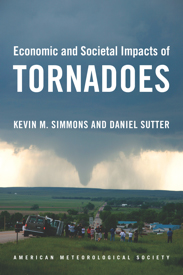 Today marks the release of a new AMS publication, Economic and Societal Impacts of Tornadoes. The book examines data on tornadoes and tornado casualties through the eyes of a pair of economists, Kevin Simmons and Daniel Sutter, whose personal experiences in the May 3-4 1999 Oklahoma tornadoes led to a project that explored ways to minimize tornado casualties. The book culminates more than 10 years of research. (At the Annual Meeting in Seattle, the authors talked to The Front Page about their new book.)
Today marks the release of a new AMS publication, Economic and Societal Impacts of Tornadoes. The book examines data on tornadoes and tornado casualties through the eyes of a pair of economists, Kevin Simmons and Daniel Sutter, whose personal experiences in the May 3-4 1999 Oklahoma tornadoes led to a project that explored ways to minimize tornado casualties. The book culminates more than 10 years of research. (At the Annual Meeting in Seattle, the authors talked to The Front Page about their new book.)
Check out the online bookstore to purchase this and other AMS titles.
 Matt
Matt
Here Comes the Sun–All 360 Degrees
The understanding and forecasting of space weather could take great steps forward with the help of NASA’s Solar Terrestrial Relations Observatory (STEREO) mission, which recently captured the first-ever images taken simultaneously from opposite sides of the sun. NASA launched two STEREO probes in October of 2006, and on February 6 they finally reached their positions 180 degrees apart from each other, where they could each photograph half of the sun. The STEREO probes are tuned to wavelengths of extreme ultraviolet radiation that will allow them to monitor such solar activity as sunspots, flares, tsunamis, and magnetic filaments, and the probes’ positioning means that this activity will never be hidden, so storms originating from the far side of the sun will no longer be a surprise. The 360-degree views will also facilitate the study of other solar phenomenon, such as the possibility that solar eruptions on opposite sides of the sun can gain intensity by feeding off each other. The NASA clip below includes video of the historic 360-degree view.
A New Way to Look at Tornadoes
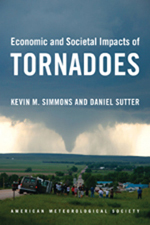 Its official release isn’t until next month, but the newest AMS book, Economic and Societal Impacts of Tornadoes, is debuting here in Seattle. The authors, Kevin Simmons and Daniel Sutter, are economists who gathered U.S. tornado casualty data from sources such as NOAA and the U.S. Census and used an economic approach to evaluate the National Weather Service’s efforts to reduce those casualties. The communication theme is a significant aspect of their analysis, and their book discloses some interesting findings on the efficacy of tornado warnings in the United States. The authors sat down with us at the Meeting to discuss their book and research.
Its official release isn’t until next month, but the newest AMS book, Economic and Societal Impacts of Tornadoes, is debuting here in Seattle. The authors, Kevin Simmons and Daniel Sutter, are economists who gathered U.S. tornado casualty data from sources such as NOAA and the U.S. Census and used an economic approach to evaluate the National Weather Service’s efforts to reduce those casualties. The communication theme is a significant aspect of their analysis, and their book discloses some interesting findings on the efficacy of tornado warnings in the United States. The authors sat down with us at the Meeting to discuss their book and research.
[And remember that other AMS books can be purchased at the skybridge near the AMS Resource Center (Exhibit Hall 4D). Signings will also be held there throughout the week–watch for the tweets!]
Meet the Winners, Then Read Their Books
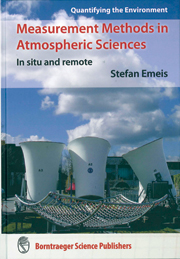 Got a long flight home after the meeting? Looking for some reading material to help pass the time? Then you should stop by the Atmospheric Science Librarians International booth (# 121) in the main Exhibit Hall at 4:45 p.m. on Wednesday for the 2011 ASLI’s Choice Book Awards. The ceremony will offer an opportunity to hobnob with some of the literati, as a number of authors of the honored books will be present to accept their awards.
Got a long flight home after the meeting? Looking for some reading material to help pass the time? Then you should stop by the Atmospheric Science Librarians International booth (# 121) in the main Exhibit Hall at 4:45 p.m. on Wednesday for the 2011 ASLI’s Choice Book Awards. The ceremony will offer an opportunity to hobnob with some of the literati, as a number of authors of the honored books will be present to accept their awards.
The ASLI’s Choice Committee selected the best titles from 2010 in three categories: science, history, and popular.
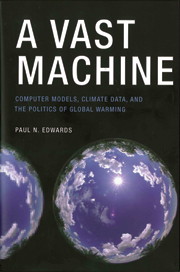 The winner in the science category is Measurement Methods in Atmospheric Sciences: In Situ and Remote, by Stefan Emeis, which ASLI chose for being “a comprehensive overview of the many atmospheric monitoring and measurement methods and instruments.”
The winner in the science category is Measurement Methods in Atmospheric Sciences: In Situ and Remote, by Stefan Emeis, which ASLI chose for being “a comprehensive overview of the many atmospheric monitoring and measurement methods and instruments.”
The top choice in the history category is Vast Machine: Computer Models, Climate Data, and the Politics of Global Warming, by Paul N. Edwards, selected for its “insightful analysis of the models and data that form the basis of our understanding of climate change.”
In the popular category, the winner is The Encyclopedia of Weather and Climate Change : A Complete Visual Guide, 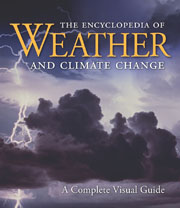 by Juliane L. Fry, Hans-F Graf, Richard Grotjahn, Marilyn N. Raphael, Clive Saunders, and Richard Whitaker, which ASLI describes as a “beautifully illustrated, authoritative and succinct introduction to meteorology and climate.”
by Juliane L. Fry, Hans-F Graf, Richard Grotjahn, Marilyn N. Raphael, Clive Saunders, and Richard Whitaker, which ASLI describes as a “beautifully illustrated, authoritative and succinct introduction to meteorology and climate.”
For the second year in a row, an AMS title will be feted, as Weather on the Air: A History of Broadcast Meteorology received an honorable mention in the history category. Author Robert Henson will be at the ceremony to accept his award, and he’ll also be signing copies of the book on the skybridge near the AMS Resource Center (Exhibit Hall 4D) on Wednesday from 2:45 to 4:00 p.m.
Top 10 Lists, NOAA-Style
The arrival of a new year is a good time to reflect on the significant events of the past 12 months. On Monday, Deke Arndt of NOAA’s National Climatic Data Center highlighted the noteworthy trends and events of 2010 in his talk, “The Climate of 2010 in Historical Perspective.” The presentation included these top-10 lists of notable 2010 events, as voted by a panel of weather and climate experts.
National Events
1. Consecutive Winter Blizzards/Extreme Snow Season (December-February)
2. Nashville and Central TN flooding (May)
3. Hot Summer in the East (June-August)
4. Midwest Super Storm (October)
5. Hawaiian Drought (Throughout 2010)
6. No hurricanes made U.S. landfall despite active Atlantic (June-November)
7. Near Eradication of CONUS Drought (July)

8. Vivian, SD Hailstone (July)
9. New England Flooding (February-April)
10. Minnesota as tornado leader (Spring & Summer)
Global Events
1. Russo-European-Asian Heat Waves (Summer)
2. 2010 as [near] warmest on record (Calendar Year)
3. Pakistani Flooding (Late July into August)
4. El Niño to La Niña Transition (Mid-to-Late Boreal Spring)
5. Negative Arctic Oscillation (December-February)
6. Brazillian Drought (Ongoing)
7. Historically inactive NE Pacific Hurricane Season (May 15-November 30)
8. Historic N. Hemispheric Snow Retreat (January through June)
9. Minimum Sea Ice Extent (Mid September)
10. China Drought (First half of 2010)
Turning Scientists into Communicators
With the word “communication” flying around the meeting all week, it might become easy to lose track of how it applies to each of us as individuals–or whether it applies to us at all. Does your role as a meteorologist also involve being a communicator? Isn’t that the job of the professional communicators?
This weekend’s communication workshop, “Integrating Communication, Weather, and Climate: More Than Just ”Talking about the Weather!’, asked those questions to some communication professionals, and their answers provided new insights to the many meteorologists in attendance. They ultimately agreed on a couple of key points: 1) the complexities of climate science make communication particularly difficult, and 2) we all have a role in communicating our science, whether it be to the public, government officials, colleagues, students, or even to our families, neighbors, and friends.
And why shouldn’t scientists also be communicators? Panelist Kim Curtis of Resource Media pointed out that scientists are among the most trusted groups by the public, more than even friends and family (and that is despite the fact that only 18% of the public actually know a scientist personally.)

The problem is that there are serious obstacles to getting the message through to the public and insuring they are receiving accurate information. Kathy Rowan of George Mason University highlighted the difficulties of communicating slow-onset risks–that is, hazards (such as long-term climate change) that progress over an extended period of time. She pointed out that humans are wired to focus on what is directly in front of them and often have difficulty looking into the future.
Expanding on that point, Bud Ward of the Yale Forum on Climate Change and the Media pointed out that when discussing climate change, the public has difficulty accepting costs that must be paid today when tangible benefits may not be felt for a very long time. As he mentioned, we have trouble even agreeing whether to use the term”climate change” or “global warming.” And of course, there are the political aspects related to communicating climate to the public. All of this obviously generates confusion.
So how can scientists overcome these difficulties and act as de facto communicators? The panelists’ recommendations included making explanations as succint and as simple as possible and addressing and discussing uncertainty in science rather than ignoring it. But the prevailing opinion was that scientists communicate most effectively when they make science relevant to the public. Some panelists noted the importance of telling stories that help the public understand how climate impacts their daily lives. And Ward explained how he avoids contentious political discussion when he speaks to local communities by emphasizing the specific ways climate could impact those areas.
According to the panelists, the ultimate goal is make science interesting to the general public while also providing technically accurate information–a fine balance, indeed, but one that hopefully will become less daunting after this week’s meeting.
Bring Your Popcorn!
Satisfy your movie fix all week at the Weather Video Preview Theater in room 303. Close to 50 different movies will be shown throughout the meeting, with screenings running from 8:00 a.m. to 5:30 p.m. every day. DVDs of many of the movies will be available for purchase at the AMS Resource Center in Exhibit Hall 4D (they can also be found online at http://www.sky-fire.tv/index.cgi/INDEX.HTML), and a portion of proceeds from every DVD sold will be directed to AMS educational and outreach programs.
The movies were specifically chosen for the quality of both their production and their scientific content, with the subject matter ranging from the quick-moving (lightning, tornadoes, hurricanes, and extreme storms of all kinds) to the slowest of the slow (glaciers).
Among those films that are back by popular demand are the British Broadcasting Cooperation’s Cloudspotting program (a compilation of high-definition time-lapse skyscapes set to music), as well as features from the National Science Foundation’s series for the ResearchChannel.
Check out below the preview of the Nova special, Hunt for the Supertwister, one of the films to be featured at the Preview Theater.
Comrades in Communication
The weekend’s workshop on “Integrating Communication, Weather, and Climate: More Than Just ‘Talking About the Weather!'” was the result of a collaborative effort between the AMS and the National Communication Association (NCA), a nonprofit organization dedicated to the advancement of communication throughout society. The NCA will continue to be a presence at the meeting throughout the week, helping to contribute to the unique interdisciplinarity this year in Seattle.
Nowhere to Hide from Snow . . . Except Florida
It snowed throughout the Northeast on Wednesday, but very few are feeling sorry for everyone in that region who had to pull out their shovels. The odds are good that you or someone you know in your state has had to deal with snow lately, too–no matter where you live in the country. According to the NWS’s National Operational Hydrologic Remote Sensing Center, which collects snow cover and depth data from ground reports and satellite observations, 49 of the 50 states currently have some snow cover…even Hawaii (this video was taken last month)! Only Florida has avoided a recent visit from Jack Frost.
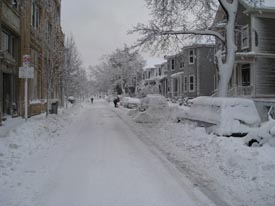
This isn’t an unprecedented event–in fact, all 50 states had snow on the ground last February 12th, and University of Oklahoma meteorology student and AMS student member Patrick Marsh obtained pictures from every state of that day’s snow.
But “it’s not typical,” says James Peronto, public affairs officer for the NWS, who noted that recent snowfall throughout the Southeast has created the unusually white map.
“The Southern states don’t typically get significant snow amounts through the year,” Peronto said. “It takes a special kind of weather scenario to allow that to happen.”
(This quick history lesson on Southern snow illustrates how rarely such a scenario occurs.)
NWS observations show that 70.9% of the country was covered by snow as of yesterday, compared to an average of 35% snow cover in December.

Snow cover and depth analyses like these are not just for interstate precipitation bragging rights or cabin-fever consolation. At the AMS Annual Meeting in Seattle, a number of science presentations will show the value of snow cover observations.
For example, Patricia de Rosnay et al. will present recent “major changes implemented” in the operational surface analysis of the European Center for Medium-range Weather Forecasting’s Integrated Forecasting System,” including a method of combining satellite observations of snow cover for the land surface conditions for weather modeling. (Tuesday, 25 January, 1:45 p.m.; WSCC 611).
Sujay Kumar et al. (poster 42, 9:45 a.m.-11:15 a.m., Tuesday, 25 January), will discuss snow cover from active microwave remote sensing and look at the value of assimilating snow observations from multiple satellites for hydrological modeling. They point out that “Snow conditions on the land surface are … key components of the global hydrological cycle as they play a critical role in the determination of local and regional climate.”
One way in which this is true is in regions where melted snow dominates water supply. On Thursday 27 January (4:15 p.m., WSCC 611) Randal Koster et al. will “examine how knowledge of mid-winter snow accumulation and soil moisture contributes to our ability to predict streamflow months in advance.” In an experiment with multiple land surface models, “snowpack information by itself contributes, as expected, to skill attained in streamflow prediction, particularly in the mountainous west.” (They go on to show the additional importance of soil moisture conditions to long-lead forecasts, particularly in winter.)
Meanwhile, as a basis for the observations used in such studies, Ding Liang et al. (Poster 595; 8:30 a.m-4 p.m., Wednesday, 26 January) will delve into improvements for modeling of microwave emissivity of snow—an important step toward constructed improved snow cover data retrieved from satellite remote sensing.
Uccellini Is AMS President-Elect
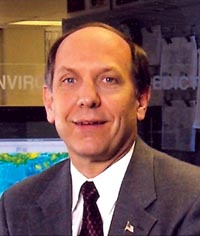
With a huge snowstorm blowing through the northeast United States, it seems an appropriate time to announce that Louis Uccellini has been voted the new AMS president-elect. The director of the National Weather Service’s National Centers for Environmental Prediction, Uccellini has coauthored two acclaimed AMS books on just the kind of snow the Northeast received today: Snowstorms Along the Northeastern Coast of the United States: 1955 to 1985 and Northeast Snowstorms. Uccellini will take over as AMS president in January 2012.
Four new councilors were also chosen in the elections: Peter J. Lamb, Patricia A. Phoebus, William L. Read, and H. Joe Witte. They began their three-year terms in January.
The AMS congratulates all the winners!